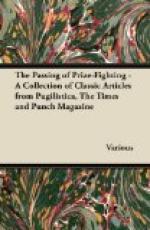* * * * *
Much as I have enjoyed some previous work by Baroness VON HUTTEN I am glad to say that I consider Magpie (HUTCHINSON) her best yet. It is indeed a long time since I read a happier or more holding story. The title is a punning one, as the heroine’s name is really Margaret Pye, but I am more than willing to overlook this for the sake of the pleasantly-drawn young woman to whom it refers and the general interest of the tale. Briefly, this has two movements, one forward, which deals with the evolution of Mag from a fat, rather down-at-heel little carrier of washing into the charming young lady of the cover; the other retrospective, and concerned with the mystery of a wonderful artist who has disappeared before the story opens. I have no idea of clearing up, or even further indicating, this problem to you. But I will say that the secret is so adroitly kept that the perfect orgy of elucidation in the final chapter left me a little breathless. Of course the whole thing is a fairy tale, with a baker’s dozen of glaring improbabilities; but I am much mistaken if you will enjoy it the less for that. A quaint personal touch, which (to anyone who does not recall the cast of Pinkie and the Fairies on its revival) might well seem an impertinence, produced in me the comfortable glow of superiority that rewards the well-informed. But I can assure Baroness VON HUTTEN that she is all wrong about the acting of that particular part.
* * * * *
As it is not Mr. Punch’s habit to admit reviews of periodical publications, I ought to say that the case of The New Europe (CONSTABLE), whose first completed volume lies before me, is exceptional. In thirty years’ experience of journalism I never remember a paper containing so much “meat”—some of it pretty strong meat, too—in proportion to its size. In hardly a single week since its first issue in October last have I failed to find between its tangerine-coloured covers some article giving me information that I did not know before, or furnishing a fresh view of something with which I thought myself familiar. And I take it there are many other writers—and even, perhaps, some statesmen—who have enjoyed the same experience. Dr. SETON-WATSON and the accomplished collaborators who march under his orange oriflamme may not always convince us (I am not sure, for example, that Austria est delenda may prove the only or the best prescription for bringing freedom to the




